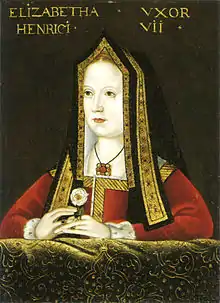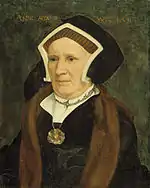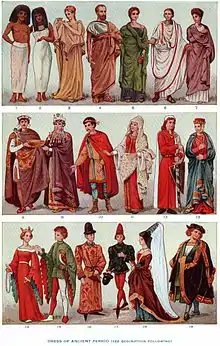Gable hood
A gable hood, English hood or gable headdress is an English woman's headdress of c. 1500–1550, so-called because its pointed shape resembles the gable of a house. The contemporary French hood was rounded in outline and unlike the gable hood, less conservative, displaying the front part of the hair.
.JPG.webp)
Mary Wotton, Lady Guildenford, wearing a gable hood with pinned up lappets and a hanging veil. Hans Holbein the Younger, 1527.
Originally a simple pointed hood with decorated side panels called lappets and a veil at the back, over time the gable hood became a complex construction stiffened with buckram, with a box-shaped back and two tube-shaped hanging veils at 90-degree angles; the hanging veils and lappets could be pinned up in a variety of ways to make complex headdresses.
Gallery
 Early gable hood: Elizabeth of York c. 1500
Early gable hood: Elizabeth of York c. 1500 Front and back views of a box-backed gable hood of c. 1528–30. Detail of a drawing by Holbein
Front and back views of a box-backed gable hood of c. 1528–30. Detail of a drawing by Holbein Gable hood with lappets and one side of veil pinned up (engraving after Holbein c. 1535)
Gable hood with lappets and one side of veil pinned up (engraving after Holbein c. 1535) Gable hood of c. 1543
Gable hood of c. 1543
References
External links
| Wikimedia Commons has media related to Gable hood. |
This article is issued from Wikipedia. The text is licensed under Creative Commons - Attribution - Sharealike. Additional terms may apply for the media files.
